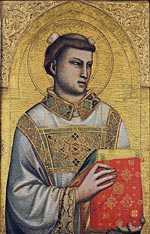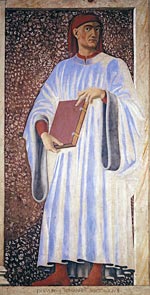Here are found some emblematic works by three great
artists from the Mugello who contributed to profound
changes in the art of their times.
 Giotto, born in Colle di
Vespignano near Vicchio around 1266, translated the by
then antiquated “Greek” of the Byzantine tradition into
the clear “Latin” of the modern figurative style. It is
seen in the strong features of the two Saints’ faces in
the two small panel paintings, part of a predella
(Florence, Ente Cassa di Risparmio di Firenze
Collection) and, above all, in Saint Stephen,
(Florence, Horne Foundation Museum), a panel of a
polyptych where the deacon, dressed in a precious
dalmatic, stands out statuesquely on a gold background.
He holds firmly in his hand a holy book draped so that
the figure of this handsome and “true” young man seems
to project out from the space of the painting. In fact,
it must have seemed so to whoever looked at it, in
1320, with eyes still mainly used to the fixed
Byzantine two-dimensionality.
Giotto, born in Colle di
Vespignano near Vicchio around 1266, translated the by
then antiquated “Greek” of the Byzantine tradition into
the clear “Latin” of the modern figurative style. It is
seen in the strong features of the two Saints’ faces in
the two small panel paintings, part of a predella
(Florence, Ente Cassa di Risparmio di Firenze
Collection) and, above all, in Saint Stephen,
(Florence, Horne Foundation Museum), a panel of a
polyptych where the deacon, dressed in a precious
dalmatic, stands out statuesquely on a gold background.
He holds firmly in his hand a holy book draped so that
the figure of this handsome and “true” young man seems
to project out from the space of the painting. In fact,
it must have seemed so to whoever looked at it, in
1320, with eyes still mainly used to the fixed
Byzantine two-dimensionality.
 Fra Angelico, born at the end of
the 14th century in Vicchio, carried painting from the
late Gothic world into that of the Renaissance,
reconciling the “ancient” with the “modern” in a
superior and “very gentle” synthesis of faith and
reason. In the altarpiece for the main altar of the
Bosco ai Frati church (Florence, San Marco Museum),
commissioned to the painter by Cosimo the Elder after
1450, the saints, all in 15th-century robes, live in
the refined classical space of the scene, defined by
the deep central exedra covered by a gilded shell
holding the Virgin with Child and angels, by the floor
perspective in the foreground, and by the background
wall where the trabeated columns and niches and
marquetries recreate the atmosphere of a joyful and
magnificent Roman domus, colored by very precious
marble and fabrics.
Fra Angelico, born at the end of
the 14th century in Vicchio, carried painting from the
late Gothic world into that of the Renaissance,
reconciling the “ancient” with the “modern” in a
superior and “very gentle” synthesis of faith and
reason. In the altarpiece for the main altar of the
Bosco ai Frati church (Florence, San Marco Museum),
commissioned to the painter by Cosimo the Elder after
1450, the saints, all in 15th-century robes, live in
the refined classical space of the scene, defined by
the deep central exedra covered by a gilded shell
holding the Virgin with Child and angels, by the floor
perspective in the foreground, and by the background
wall where the trabeated columns and niches and
marquetries recreate the atmosphere of a joyful and
magnificent Roman domus, colored by very precious
marble and fabrics.
 Andrea del Castagno, whose name
preserves the memory of his native village in the
Mugello mountains, instead, presents a heroic
interpretation of the Renaissance. So the great men of
letters from the recent Middle Ages, Dante and
Boccaccio leap into the foreground with the force of
“modern” orators in the frescoes from 1448-1449 (thus
contemporary to the altarpiece by Fra Angelico) from
Villa Carducci in Legnaia near Florence (Florence,
Uffizi Gallery). Their very solid bodies do not seem to
belong to the pictorial space, a sort of antique-style
theatrical set, all covered with polychrome marble and
articulated by classical pilasters, but rather to a
real space (observe the bold perspective of those
extraordinary feet and hands), ready for action just as
required by the best civic Florentine Humanism of
Leonardo Bruni, Coluccio Salutati, and Leon Battista
Alberti.
Andrea del Castagno, whose name
preserves the memory of his native village in the
Mugello mountains, instead, presents a heroic
interpretation of the Renaissance. So the great men of
letters from the recent Middle Ages, Dante and
Boccaccio leap into the foreground with the force of
“modern” orators in the frescoes from 1448-1449 (thus
contemporary to the altarpiece by Fra Angelico) from
Villa Carducci in Legnaia near Florence (Florence,
Uffizi Gallery). Their very solid bodies do not seem to
belong to the pictorial space, a sort of antique-style
theatrical set, all covered with polychrome marble and
articulated by classical pilasters, but rather to a
real space (observe the bold perspective of those
extraordinary feet and hands), ready for action just as
required by the best civic Florentine Humanism of
Leonardo Bruni, Coluccio Salutati, and Leon Battista
Alberti.



The Mugello and the Arts: Giotto, Fra Angelico and Andrea del Castagno
Giotto
Fra Angelico
Andrea del Castagno